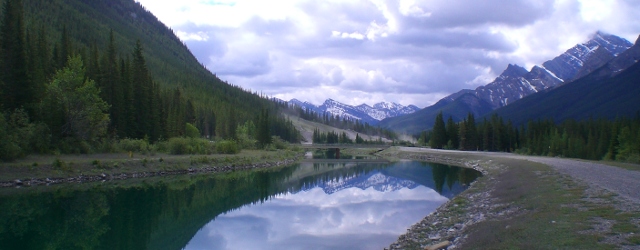Wind is an energy resource
Wind does not always produce power, but it can be relied upon to be an energy resource of relatively predictable value when looking at long time-frames. For instance, if I know that the Centennial Wind Farm in Saskatchewan has a capacity factor of 42.4%, then I can expect that on average it will be producing about 42.4% of the total energy that it could have during a long time period such as a year1 . Since the Centennial Wind Farm is 150 MW at max power, 42.4% capacity factor means that it has an average output of 63.6 MW.
This is certainly not to say that the wind farm would simply be producing 63.6 MW all the time. The power production jumps up and down depending on the wind conditions. What we are saying is that it can be counted on to produce an expected amount of energy when we look at its output over long time scales.
Leverage hydro to use wind
When wind isn’t blowing hard, use a dispatchable source such as hydro to produce power. Let’s assume that we have 150 MW of hydro on hand to cover the Centennial Wind Farm when the wind isn’t blowing. If we look at entire year of production, we can expect that about 42.4% of all energy will have come from the wind, and that the remaining 57.6% of the energy would have come from the hydro. What is necessary for a system like this to work is to have enough water behind the hydro dam that it can cover a fairly long spell of low winds. This could be as long as several days. If our hydro reservoir is big enough to cover that time, we should be able to cover the intermittent nature of the wind for the whole year. If it isn’t big enough, we will have to get our power from elsewhere. Perhaps importing it from neighboring grids or by using another source such as natural gas.
Looking at this in another way, we save 42.4% of the water we would otherwise have to run out of our hydro dam by having an equal sized wind setup. Admittedly the Centennial Wind Farm has an extremely good capacity factor. Not all wind farms have as high of a capacity factor. The concept remains the same however even if the capacity factor were lower. We can reduce the water we use in hydro, or the fuel we use for natural gas, by coupling these systems with wind.
Leverage dispatchable to use intermittent
The example in the last section was very simplistic, but the concept it demonstrated can work in general. Intermittent sources can be used to reduce the amount we need to use our dispatchable sources. This can save us money and CO2 emissions in the case of natural gas. In the case of a source like hydro, it may give us the freedom to leverage it even more. The water that we don’t run out of the dam because we have built wind for instance could be used to cover even more intermittent generation capacity.
What this means is that if we save 40% of our hydro resource (the water behind the dam) per year because we have built a large scale wind project, we could use that 40% remaining to cover another wind project that is almost as big as the first one, since we still have almost half our water left. A practical situation would have more things to consider, but the key point I am trying to make is that hydro is a finite resource of dispatchable renewable power that we should maximize the use of. Coupling it to other renewable sources is a key facet of making a green reliable power grid.
For more information, see our article on creating dispatchable power from renewables.
Larger dispatchable hydro power with the same reservoir
It is possible to leverage the same reservoir different amounts, depending on the maximum speed with which it can be safely drained through the turbines. If we are trying to maximize the ability hydro has to cover the intermittent nature of other power types, then we might be advised to increase the amount of power we can draw from it at once by building more turbines. This would mean of course that at maximum flow, the reservoir would be emptied more quickly than before. It would also mean however that we could be covering the intermittent nature of a larger amount of renewable power generation such as wind or solar. As long as we make sure that we don’t run our hydro dry by over-leveraging it, we will be making more effective use of its abilities.
Ideally we would be able to use our hydro resources as a complement to wind and solar on a system. In the interests of making our energy system more environmentally friendly, it makes sense to maximize the utility we get from our hydro reservoirs by coupling them in this way to generate far more total electricity than they could alone.
In closing it is important to note that intermittent sources such as wind and solar quite often complement each other to some degree. It is generally more windy at night, and midday often sees reduced winds. This is the reverse of the expectation of energy from solar sources. The more intermittent sources there are on a system, and the greater their geographical spread, the more they are expected statistically to complement each other. This means that as a whole, the intermittent energy resources can be made more reliable by building more types and spreading them out geographically.
- Centennial Wind Power Facility Rides the Wind to a Great First Year. SaskPower, June 14th, 2007. Retrieved Sep 9th, 2010. [↩]

10 thoughts to “Leverage hydro to use wind”